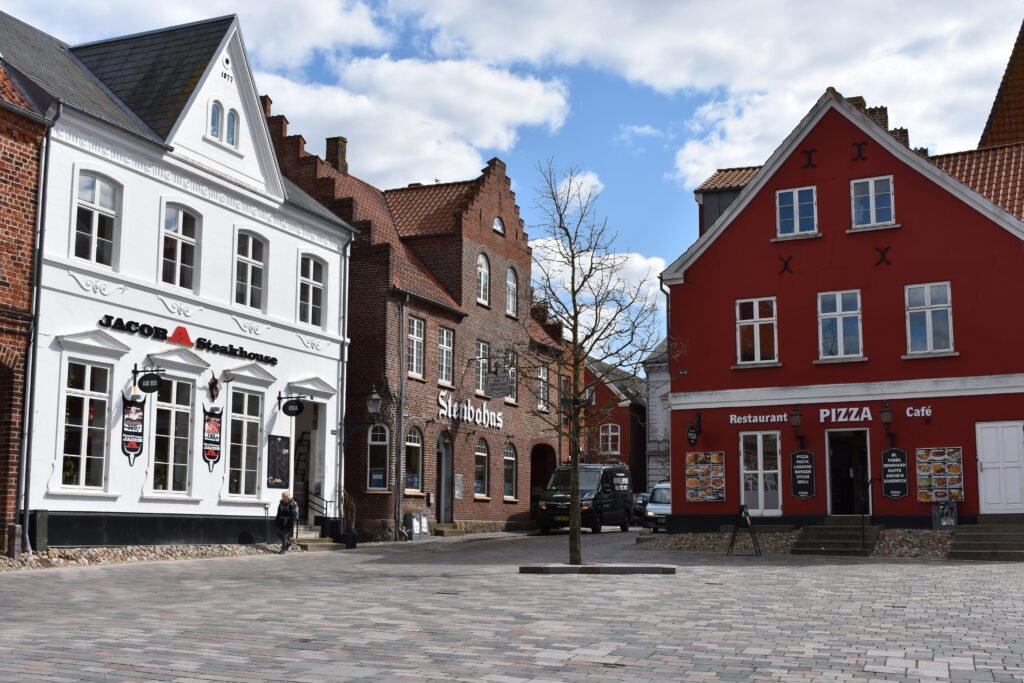
The Region of Southern Denmark has some historic places such as Ribe and Odense. While it isn’t the most visited part of Denmark – that honor goes to the Capital Region – it is often very practical and easy to visit Southern Denmark. For instance, if you’re doing a road trip through Europe, if you’re staying in Germany and want to do a day trip to Denmark, or if you are flying in through Billund Airport.
In this article, we intend to share a lot of practical information about visiting the Southern Denmark Region, plus a bit of inspiration for your trip!
Contents
Facts about Southern Denmark
Denmark is split into five regions, and Southern Denmark is one of them. In Danish it is known as “Region Syddanmark”. It contains the bottom third of Jutland, the island of Funen, and several smaller islands. There are 22 municipalities in the region and a population of 1.2 million people.
The largest city in the region is Odense. Other important cities are the port city Esbjerg, the historic city Ribe, and the triangle area of Vejle, Kolding and Fredericia which has basically merged into one large metropolitan area. Vejle serves as the political capital of the region.
Danish is obviously the language that is spoken. However, people have a distinct dialect in comparison to other Danish regions. A minority living along the German border speak German as their main language. Almost everyone in the region is capable of speaking English as well.
Southern Denmark is connected to the Central Denmark Region by countless roads and connected to Zealand by bridge and tunnel.
Generally speaking, this region is more industrial than other Danish regions, and it also has plenty of farmland. There is one university, Syddansk Universitet. Its main campus is in Odense but there are also faculties in Kolding, Esbjerg and Sønderborg.
Best destinations in Southern Denmark
Wondering which cities, towns and natural areas that are best to visit?
In truth, there are a lot of options. If you want a city trip, Odense is the only place that qualifies. Odense is by far the biggest city of the region and it has the best nightlife, the best shopping facilities, and the highest number of hotels.
Esbjerg is a popular destination since it is a prominent port city on the western coast. Many travelers come in by ferry. Esbjerg is a cozy city, not too large, but with some decent things to do. Near Esbjerg we find the island Fanø which is incredibly idyllic and popular among Danish domestic tourists. We highly recommend you to spend a day on Fanø, since the island is just beautiful, and it has traditional houses and many locally owned restaurants.
Ribe is Denmark’s oldest city and it is situated in this region. Classified as a city due to the presence of a Cathedral but with the size of a village. Ribe is not very large, but it has some of Denmark’s best attractions which includes several museums and the oldest hotel in the country where you can actually stay.
Vejle, Kolding and Fredericia are often grouped together as “the Triangle Area”. It is worth it to visit Vejle and Kolding, although Fredericia isn’t much of a tourist town. Vejle has a nice landscape – it is the hilliest city in Denmark – and Kolding has a decent nightlife.
The historic town Sønderborg should also be visited. It has a rich history and it is a somewhat popular tourist destination.
Small town Dybbøl has one of Denmark’s national monuments and one of the countries most famous symbols – the Dybbøl Mill, a symbol of the Schleswig Wars in the 19th century. If you’re going on a road trip, it absolutely makes sense to stop by Dybbøl for an hour to see this attraction.
And the best for last: The original Legoland in Billund. Many families go to Southern Denmark solely to visit Legoland, which is obviously one of Denmark’s best attraction parks. Billund also has the country’s second-largest airport so if you are flying in, Billund will automatically be your first destination.
Getting in and out
Billund Airport is the main airport in the region. So if you want to fly in, this will always be the best option. However, you can also fly to Copenhagen and take the train onwards to the region. Takes a bit longer, but it could potentially be easier to find tickets to Copenhagen since there are more connections.
A lot of German tourists visit the region, coming in by car. This is very easy, there is rarely any border control, and the Southern Denmark region is naturally the first one you reach as you cross the Danish border from Germany.
Trains are also coming in from Germany. Often it is quite affordable to take the train, and it is also good for the environment, so it has become an increasingly popular option.
In the past, a lot of ferries were coming to Esbjerg, but nowadays there are only a few connections. Unfortunately, the historic connection between London and Esbjerg has been discontinued. Now, Esbjerg mostly has ferries to the smaller Danish islands in the vicinity.
Best time to go
The summer is the best time to visit. This is when the weather is at its absolute best. The Danish summer is generally very nice – on most days, temperatures are warm with plenty of sunshine.
For the rest of the year, you won’t get as much sun, and you will definitely have to bring a jacket, but the attractions in the region remain just as great.
To learn more about this, check our article about the best time to visit Denmark.
Southern Denmark vacation package
We don’t offer any Southern Denmark vacation packages at the moment, but you can arrange your stay by booking a hotel or a holiday apartment on Booking.com.
If you have any questions regarding your trip to this Danish region, feel free to write in the section below!








